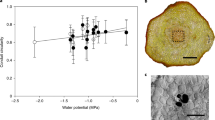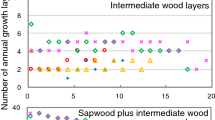Summary
Xylem (wood) tissue in plants functions both for mechanical support and water transport. Since vines are mechanical parasites, they allocate less biomass for xylem tissue than do free-standing trees or shrubs. With-in the genus Bauhinia, stems of vine species were found to have not only less xylem per distal leaf area, but also less phloem and cortical tissue when compared to tree and shrub species. The phloem and cortical reductions are interpreted as an indirect effect of the developmental/geometric constraints imposed by the evolution of a reduced mechanical system. Apparently vines overcame these constraints with the evolution of wider vessels and wider sieve tubes and with many types of variant (anomalous) secondary growth. The long and wide vessels of vines, which compensate hydraulically for the reduced xylem areas, may help limit the distribution of vine species in nature.
Similar content being viewed by others
References
Ayensu ES, Stern WL (1964) Systematic anatomy and ontogeny of the stem in Passifloraceae. Contr US Nat Herb 34:45–71
Carlquist S (1975) Ecological strategies of xylem evolution. Univ Calif Press, Berkeley
Carlquist S (1988) Comparative wood anatomy. Springer, Berlin
Dobbins DR, Fisher JB (1986) Wound responses in girdled stems of lianas. Bot Gaz 147:278–289
Ewers FW (1985) Xylem structure and water transport in conifer trees, dicot trees, and lianas. Int Assoc Wood Anat Bull 6:309–317
Ewers FW, Cruiziat P (1990) Measuring water transport and storage. In: Lassoie JP, Hinckley TM (eds) Techniques and Approaches in Forest Tree Ecophysiology. CRC Press, Boca Raton 91–116
Ewers FW, Fisher JB, Chiu S-T (1990) A survey of vessel dimensions in stems of tropical lianas and other growth forms. Oecologia 84:544–552
Ewers FW, Fisher JB, Fichtner K (1991) Water flux and xylem structure in vines. In: Putz F, Bullock S, Mooney HA (eds) The Biology of Vines. Cambridge University Press, New York 119–152
Fahn A (1982) Plant Anatomy, 3rd ed. Pergamon Press, Oxford
Fisher JB, Ewers FW (1989) Wound healing in stems of lianas after twisting and girdling injuries. Bot Gaz 150:251–265
Fisher JB, Ewers FW (1991) Structural responses to stem injury in vines. In: Putz F, Bullock S, Mooney HA (eds) The Biology of Vines. Cambridge University Press, New York 119–152
Gartner BL (1991) Stem hydraulic properties of vines vs. shrubs of western poison oak, Toxicodendron diversilobum. Oecologia 87:180–189
Gartner BL, Bullock SH, Mooney HA, Brown VB, Whitbeck JL (1990) Water transport properties of vine and tree stems in a tropical deciduous forest. Am J Bot 77:742–749
Gentry A (1991) The distribution and evolution of climbing plants. In: Putz F, Bullock S, Mooney HA (eds) The Biology of Vines. Cambridge University Press, New York
Huber B (1928) Weitere quantitative Untersuchungen über das Wasserleitungssystem der Pflanzen. Jahrb Wiss Bot 67:877–959
Peñalosa J (1984) Basal branching and vegetative spread in two tropical rainforest lianas. Biotropica 16:1–9
Putz FE (1983) Liana biomass and leaf area of a “tierra firme” forest in the Rio Negro Basin, Venezuela. Biotropica 15:185–189
Putz FE (1984) The natural history of lianas on Barro Colorado Island, Panama. Ecology 65:1713–1724
Rundel PW, Franklin T (1991) Vines in arid and semi-arid ecosystems. In: Putz F, Bullock S, Mooney HA (eds) The Biology of Vines. Cambridge University Press, New York
Schenck H (1893) Beitrage zur Biologie und Anatomie der Lianen. II. Beitrage zur Anatomie der Lianen. Bot Mitt Trop 4:1–248
Sperry JS, Holbrook NM, Zimmermann MH, Tyree MT (1987) Spring filling of xylem vessels in wild grapevine. Plant Physiol 83:414–417
Stevens GC (1987) Lianas as structural parasites: the Bursera simaruba example. Ecology 68:77–81
Teramura AH, Forseth IN, Gold WG (1991) Physiological ecology of mesic, temperative vines. In: Putz F, Bullock S, Mooney HA (eds) The Biology of Vines. Cambridge University Press, New York
Welle BJH TER (1985) Differences in wood anatomy of lianas and trees. Int Assoc Wood Anat Bull 6:70
Zimmermann MH (1983) Xylem structure and the ascent of sap. Springer, Berlin
Author information
Authors and Affiliations
Rights and permissions
About this article
Cite this article
Ewers, F.W., Fisher, J.B. Why vines have narrow stems: Histological trends in Bauhinia (Fabaceae). Oecologia 88, 233–237 (1991). https://doi.org/10.1007/BF00320816
Received:
Accepted:
Issue Date:
DOI: https://doi.org/10.1007/BF00320816




